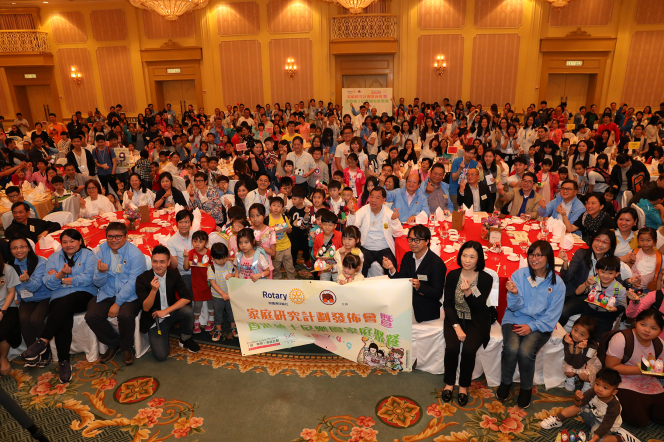Media
“Establishing Loving Connection within the Family” a preliminary report on the effectiveness of a multi-modal family-based intervention on family functioning
09 Apr 2017
Prevalence of single-parenthood and long working hours has made maintaining work-life balance more difficult than it was a decade ago. The pace of modern living has also imposed challenges to family cohesion in our society. The advancement in mobile communication devices has changed our way of connecting with each other for better and for worse. While parents are busy working to make ends meet, the arrangement of household chores has become a source of parent-child stress and a debilitating factor of family cohesion. Expression of appreciation, mutual understanding and more family-based activities are potential contributing factors to family solidarity.
Mutual care among family members is the foundation of family cohesion, which in turn builds on trust and empathy, attentive listening, expressing one’s needs, and self-disclosure (Olson, 2000). Local studies revealed that mutuality within the family has positive impacts on the mental health of adolescents. A report on the healthy use of electronic devices (Department of Health, 2014) stressed the importance of face-to-face interactions and open communications in the psycho-social-spiritual well-being of adolescents.
Deeply rooted in the Chinese cultural legacies of the teaching of Confucian, Hong Kong families adopt a “top-down” approach to parent-child communication. The authoritarian type of parenting values obedience to higher authority and disciplining as virtues, while expression of appreciations and gratitude are rare. This traditional relationship has been challenged by generations of youngsters growing up under the influence of Western culture which emphasises individuality and mutual respect. Earlier research findings indicated that an “open communication” helps cultivate rapport, trust, and cohesion with the family communication (Olson, 2000). Open parents-child communication characterises deep listening, empathy, and showing appreciations among parents and children. Family education in the past emphasised the role of parents in the parent-child relationship while downplaying the role of mutuality. In fact, each family member has a role to play in making family a haven for everyone.
In 2012-2013, the Neighborhood Action-Advice Council (NAAC) had conducted a pioneer study to explore the existing service gap in Hong Kong’s family services, which resulted in a pioneering initiative in 2016 to develop an integrative, multi-modal family intervention program for needed families residing in Sham Shui Po and Tung Chung. Under the slogan “Establishing Loving Connectedness”, the multi-modal family intervention program aims to provide a platform to build rapport, enhance parent-child communication and cultivate a sense of mutuality among family members by means of the use of creative arts modalities such as visual arts, music, dance movement, and play. One major goal of the program is to make the family a platform where its members learn and growth in a playful and loving atmosphere.
The program composes of six sessions and two family gatherings, embracing elements of traditional social support intervention and elements of arts-based intervention tailored to address the needs of local families. NAAC has partnered with the research team at the Centre on Behavioral Health, the University of Hong Kong to assess the effectiveness of the multi-modal family intervention program on the mutuality, communication, togetherness, and expression of gratitude among members in these families.
Adopting a controlled trial study design, the effectiveness of the program was assessed using questionnaire survey and focus group interviews, with participating families and case workers as respondents. Sixty families in the pioneer program were surveyed. Here are the findings:
1. Quantitative survey results reveal that the integrative, multi-modal family intervention program is effective in enhancing mutuality. Compared with participants in the control condition, participants in the intervention condition reported increment on the measure of mutuality. About 80% of the respondents said the program has improved family connection and encouraged expressions of appreciation among family members.
2. Focus group interview results reveal that the program provides the parent-child dyad with a platform to spend quality time together, establishing meaningful communications, enhancing mutual understanding and cultivating positive emotionality among family members.
3. According to the parent participants, collaborative work using arts as a medium can broaden their perspective towards their children. They have become more aware of the strengths and preferences of their children and are more ready to express gratitude and appreciation by both verbal and non-verbal means. Engaging in collaborative artwork can foster parent-child open communication while providing an opportunity for the children to show creativity and talents. Children can also learn household chores from their parents in a positive and playful manner, enhancing their willingness and enjoyment in offering help to the family.
4. The parents have found it fruitful to learn through sharing between parents and observing each other. They reported a heightened awareness of the reciprocal nature of the parent-child relationship in the family.
A big gathering of over 300 local grassroot families was held by NAAC at the Disneyland (Hong Kong) on April 9, 2017 (Sunday), with an aim to further cultivate a loving connection within the family in society. The event was made possible with the support from the Rotary Club of Causeway Bay and the sponsorship of Disney Hong Kong,
For media enquiries, please contact the Senior Administration Executive, Ms Amy Choi at Centre on Behavioral Health (Phone: 2831 5158/ Email: amychoi@hku.hk), or Senior Manager (Media) of the Communications and Public Affairs Office, Ms Melanie Wan (Phone: 2859 2600 / Email: melwkwan@hku.hk).

